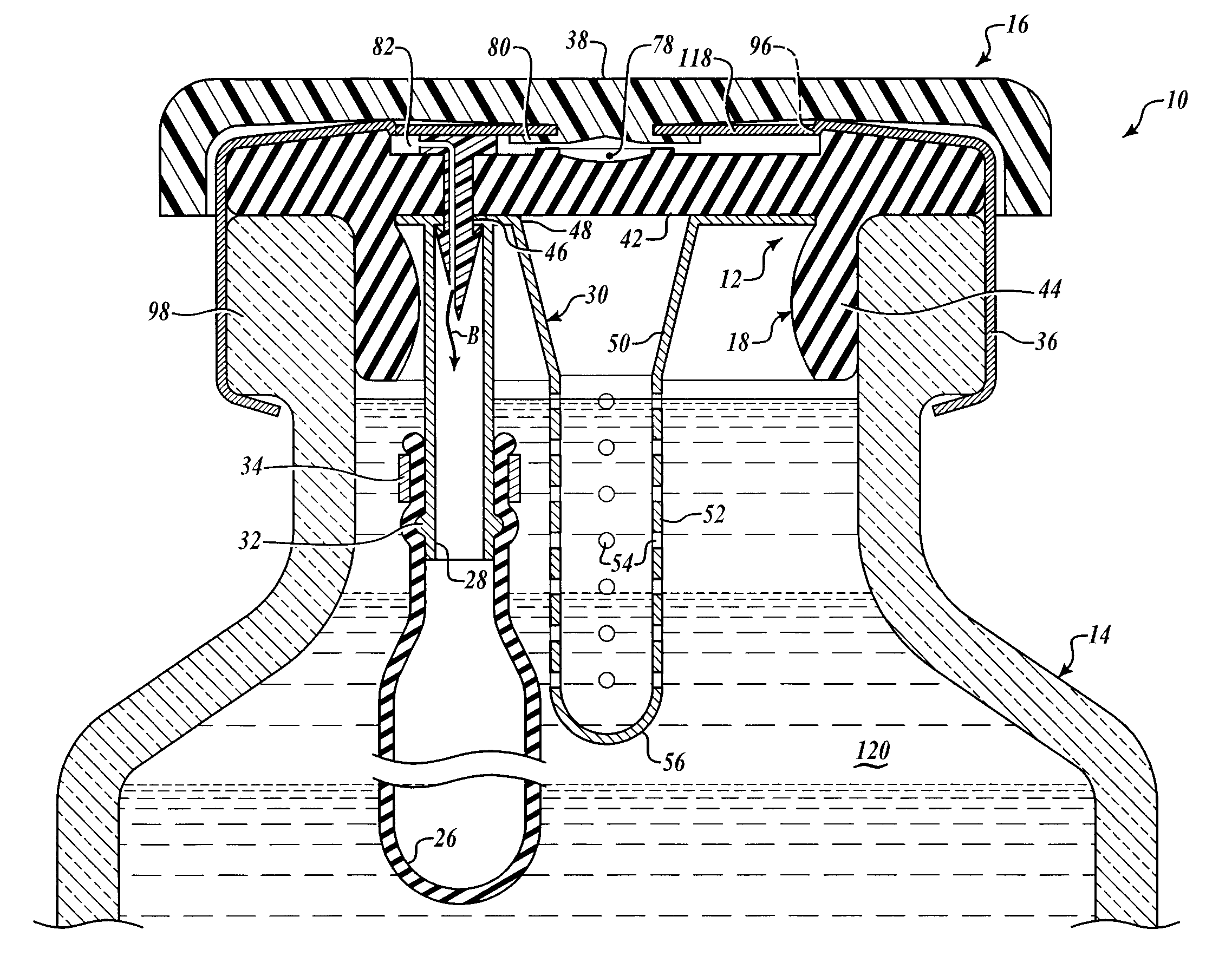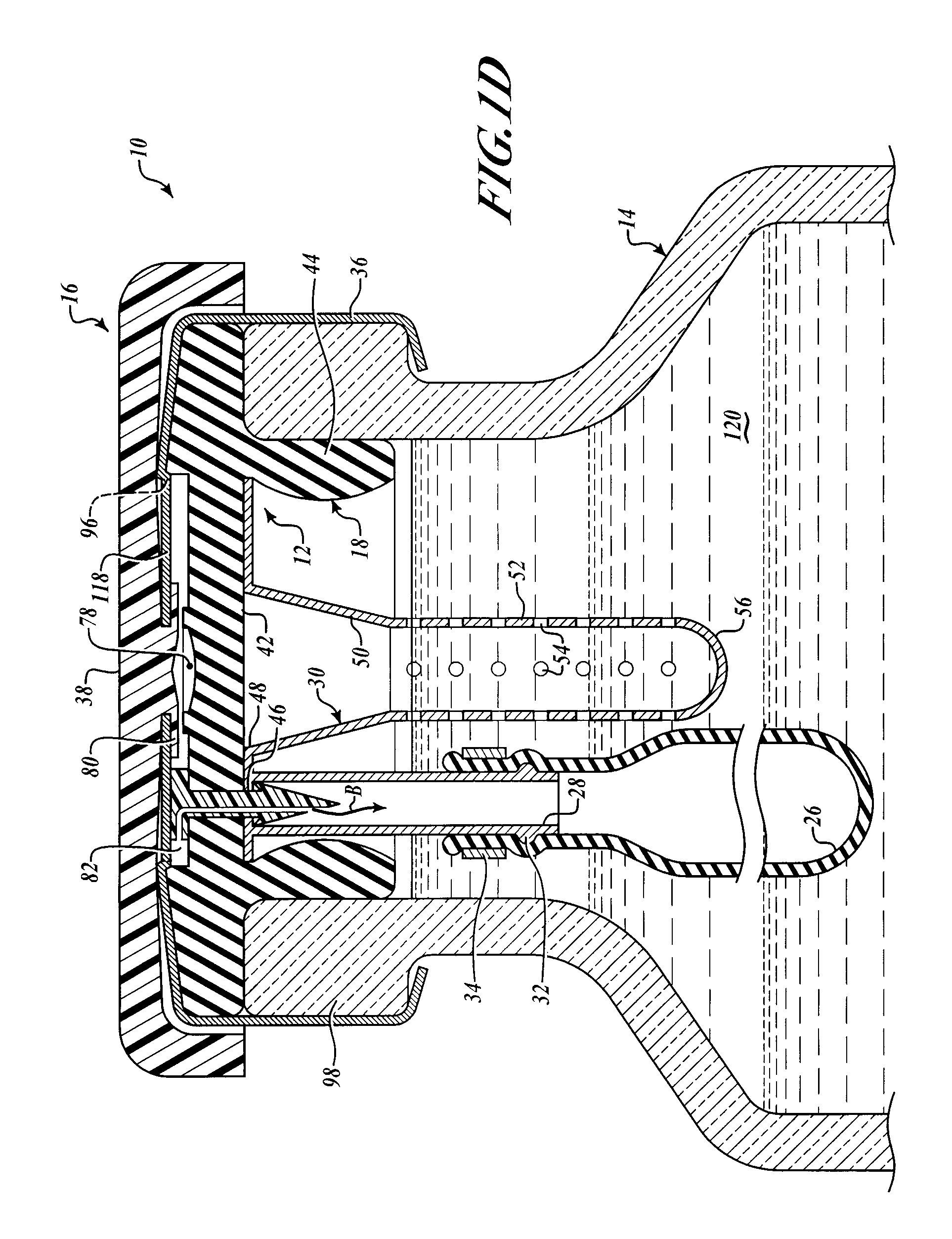Vial assembly and method for reducing nosocomial infections
a nosocomial infection and assembly method technology, applied in the field of vacuum break system, can solve the problems of air in contact with medicinal fluid, little recognition, contaminating iv fluid, and affecting the quality of the air in the bag, so as to achieve uniform and even bag collapse
- Summary
- Abstract
- Description
- Claims
- Application Information
AI Technical Summary
Benefits of technology
Problems solved by technology
Method used
Image
Examples
first embodiment
[0042]FIGS. 1A and 1B show two exemplary embodiments of the barbed vent element 22. In FIG. 1A, the barbed vent 22 comprises a flattened stud portion 60 to which is secured a stem portion 62, that terminates in a barb portion 64 that terminates in a sharp piercing point 74. A vent channel or passage 66 is provided internally of the barbed vent 22 extending from an inlet hole 70 in the stud side wall through the stem and terminating in outlet hole 72 adjacent the point 74 (see FIG. 1B). The inlet air is shown by Arrow A and the outlet air by Arrow B in FIG. 1A.
[0043]As seen in FIGS. 1C and 1D, the barbed vent element 22 secures the needle sheath and air bladder retainer assembly 24 to the underside 42 of the stopper collar 44 by application of force to the stud 60 so that the point 74 pierces the stopper neoprene, passes through the hole 46 in the annulus 40 of the needle sheath assembly 30. The barbs engage underside of the annulus adjacent hole 46, as best shown in FIG. 1D, compres...
second embodiment
[0046]FIGS. 2A and 2B show the inventive vacuum-break vial assembly 10, comprising a vial into which is fitted a full length bladder 102 that is made of a medical grade polymer to permit it being filled with a medicinal fluid 120. The bladder is configured with a neck to fit the vial neck, and a lip that generally conforms to the top lip 98 of the vial mouth. The bladder may also be a bellows configuration, or comprise an integral, relatively rigid diaphragm member at the bottom that moves upward as fluid is withdrawn. The vial also includes one or more small air vents 106 so that as fluid is withdrawn from the bladder, air can past into the space between the bladder and inner wall of the vial, permitting the bladder to contract or collapse to compensate for reduction in the volume of fluid in the vial. Recall that the vial is inverted from the orientation shown in this FIG. 2A, so that where the bottom includes a diaphragm member, it will slide down (up in the figure) to compensate...
third embodiment
[0048]FIG. 3 shows the inventive vacuum break vial assembly, in which the needle sheath 100 of FIG. 2A and FIG. 2B is fitted in a stopper with somewhat thickened collar. The cap 14 and flip-off top (not shown) are as in the other embodiments described above. An elongated vent tube 110 is inserted or cast into the wall of the stopper collar 44 as shown, and it terminates at its upper end in an air inlet 114 that provides air vial the holes 54 in the bottom section of the tube. A bladder collar 112 is fitted on the tube 110 and in turn a bladder 26 is secured by the collar. The bladder expansion is shown by Arrows C. The vial volume 116 is filled with medicinal before the stopper having the collapsed bladder wrapped around the air vent tube 110 and needle sheath assembly 100 is inserted into the vial neck. The Arrow D line shows the direction of insertion of the hypodermic in the center of the target ring 78.
[0049]It should be noted that the bladder / bellows / diaphragm may exert either ...
PUM
 Login to View More
Login to View More Abstract
Description
Claims
Application Information
 Login to View More
Login to View More - R&D
- Intellectual Property
- Life Sciences
- Materials
- Tech Scout
- Unparalleled Data Quality
- Higher Quality Content
- 60% Fewer Hallucinations
Browse by: Latest US Patents, China's latest patents, Technical Efficacy Thesaurus, Application Domain, Technology Topic, Popular Technical Reports.
© 2025 PatSnap. All rights reserved.Legal|Privacy policy|Modern Slavery Act Transparency Statement|Sitemap|About US| Contact US: help@patsnap.com



